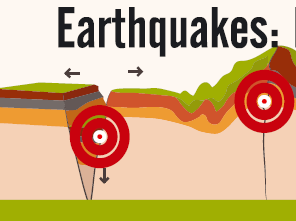Earthquakes: Movement of the Earth’s Crust
Earthquakes are the shaking and movement of the ground when energy is released in waves. These waves are called seismic waves. They are similar to ocean waves which move through water. Seismic waves, however, move through the ground.
Large sections of the earth’s crust is called plates. The movement of the plates causes most of the earthquakes. The place where the two plates meet is called a fault. Faults look like large cracks in the ground. If two plates move in different directions, they build up energy at the fault line. When enough energy builds up, the stress on the fault line becomes too great and it ruptures. This releases the energy and the ground starts to shake.
Other natural events, such as landslides and volcanoes, can cause earthquakes, too. Man-made earthquakes happen because of nuclear testing and mining explosions.
The first movement of an earthquake is called the main shock. What usually follows the main shock are aftershocks which are smaller ground trembles. These aftershocks are the plates settling into their new position. Aftershocks can continue for days after the main shock.
There are about 500,000 earthquakes around the world each year. Most are below 3.0 on the Richter Scale, which makes them unnoticeable to humans. Only about 100,000 can be felt by humans. The largest earthquake ever recorded is 9.5, and it happened in 1960 in Chile. The deadliest one, however, happened in China in 1556, causing more than 800,000 people to die.
Major earthquakes in populated areas can cause huge destruction. Buildings collapse, roads and bridges buckle and crack, and electrical and gas lines break and cause fires. If the earthquake happens in the ocean, it makes a series of huge ocean waves called a tsunami. The tsunami travels until it finally reaches land and it causes large flooding.
Scientists are searching for ways to predict earthquakes. They study the historical patterns of earthquakes and monitor the movement of the plates with seismic equipment. While they cannot predict an exact date of a future earthquake, they have a better understanding of when earthquakes are more likely to happen.

